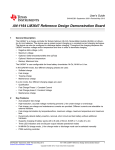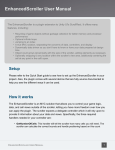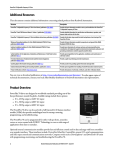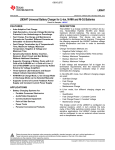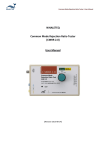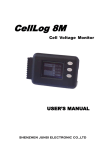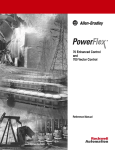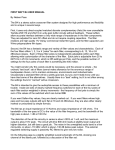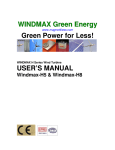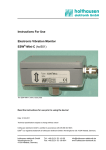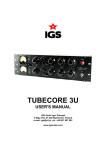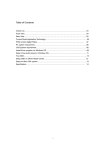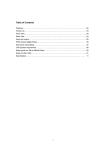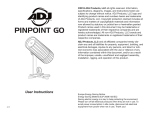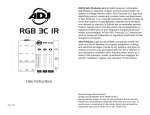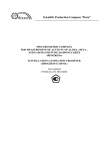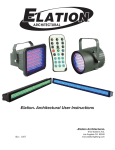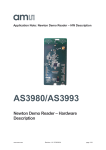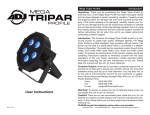Download Application Note 1164 LM3647 Reference Design User`s Manual
Transcript
LM3647 Reference Design User’s Manual GENERAL DESCRIPTION The LM3647 is a charge controller for Nickel-Cadmium (Ni-Cd), Nickel-Metal Hydride (Ni-MH) or Lithium-Ion (Li-Ion) batteries. The device uses a pulsed-current charging or a constant-current charging technique. The device can also be configured to discharge before charging. Throughout the charging sequence the LM3647 monitors voltage and/or temperature and time in order to terminate charging. • Negative delta voltage (−∆V) • Maximum voltage • Optional: Delta temperature/delta time (∆T/∆t) • Optional: Maximum temperature • Backup: Maximum time The LM3647 is user configurable for three battery chemistries: Ni-Cd, Ni-MH or Li-Ion. In Ni-Cd/Ni-MH mode, four different charging phases are used: • Softstart charge • Fast charge • Topping charge • Maintenance charge In Li-Ion mode, four different charging stages are used: • Qualification • Fast Charge Phase 1, Constant Current • Fast Charge phase 2, Constant Voltage • Maintenance charge KEY FEATURES • • Auto-adaptive fast charge • Fast charge, pre-charge and maintenance currents are provided. Different currents are selectable via external resistors • Fast-charge termination by temperature/time, maximum voltage, maximum temperature and maximum time • Dynamically detects battery insertion, removal, short circuit and bad battery without additional hardware • High-resolution, accurate voltage monitoring prevents Li-Ion under-charge or overcharge AN-1164 The high speed PWM is filtered to a DC-level and fed into an operational amplifier that controls a power-NPN transistor. The LM3467 requires charge current feedback to control the charge current. 1.2 1.2.1 Charging Ni-Cd/Ni-MH Batteries The charger detects that a battery is connected when the CEL-pin > 1.0V. The charger can also detect a battery that has been deeply discharged and does not have any voltage across the battery terminals. This is accomplished by applying a small ’pre-charge’ current once every minute for up to 15 seconds. The deeply discharged battery will accept this charge and the battery potential will eventually rise above the 1.0V limit to initiate normal charging. When the charger has detected a battery (CEL-pin > 1.0V), it checks to see if the temperature is within range to start charging. If it is, then it applies a small current of 0.2C for approximately 5 minutes. If the battery voltage exceeds the maximum battery voltage (CEL-pin > 3.017V), the LM3647 stops charging and stays in error mode until the battery is removed. If the battery voltage has not risen above the bad battery threshold (CEL-pin < 1.2V), then the battery is considered to be defective and the charger goes into error mode. If the battery passes all tests, then after the five minutes have passed, the charger starts the next phase: Fast Charge. During Fast Charge, the charger applies a constant current to the battery and monitors both battery voltage and temperature. The charger is looking for a drop in the battery voltage that normally occurs at the end of the Fast Charge cycle. The size of the voltage drop differs depending on battery type (Ni-Cd/Ni-MH). For Ni-Cd it’s approximately 50 mV/cell and for Ni-MH it’s approximately 17 mV/cell. If the temperature rise is larger than 50 mV/minute (∼1˚C/minute) when charging Ni-MH batteries, the battery has reached the end of the Fast Charge cycle. During charging the temperature-input is constantly measured to ensure that the battery’s temperature is within proper range. If the temperature is out of range the charger aborts the charge and goes into error mode. During the next charge phase (Topping Charge) the LM3647 applies a small current of 0.2C for a time set by the time-selection RC-network (see section below). This phase may be followed by a Maintenance Charge phase, depending on selection-pins. AN101315-14 Charge Current The charge settings for LM3647 current control are shown below. If the external LM317 is used to control the charge current then the jumpers J9, J10 and J13 have no relevance, when using LM317 regulation mode, this jumper must be placed in either position. If external (LM317) regulation is used then set jumper J7 to position ″slow″; for LM3647 regulation set J7 to ″fast″. LM3647 Current Regulation The I jumper J10 is used to select between different current sense resistors. The values available are 0.047Ω and 0.100Ω. AN101315-12 The charge current is set with jumpers J9 and J13. The figure shows two possible currents that depend on how jumper J10 is set. The higher current is selected when J10 is set to 0.047Ω and the lower current is selected when J10 is set to 0.100Ω. AN101315-13 1.0 1.2.2 Charging Li-Ion Batteries The charger detects that a battery is connected when the CEL-pin > 1.0V. The charger can also detect a battery that has been deeply discharged and does not have any voltage across the battery terminals. This is accomplished by applying a small ’pre-charge’ current once every minute for up to 15 seconds. The deeply discharged battery will accept this charge and the battery potential will eventually rise above the 1.0V limit to initiate normal charging. When the charger has detected a battery (CEL-pin > 1.0V), it checks to see if the temperature is within range to start charging. If it is, then it applies a small current of 0.2C for approximately 1 minute. If the battery voltage is close to fully charged, the charger will not reach the charging voltage within 1 minute, FUNCTIONAL DESCRIPTION 1.1 General The LM3647 has voltage and current sensing inputs that are used to control a PWM-output. The voltage input is connected to the battery via a resistor divider network, and the current input is connected to an operational amplifier that amplifies the voltage across a current sense resistor located at the positive battery terminal. The PWM-output can be configured as a high speed PWM, or as a low speed (ON/OFF) output for an external current regulator. The latter is for low cost Ni-Cd/Ni-MH charger applications, eliminating the need for any operational amplifiers or current feedback circuitry. www.national.com Modes of Operation 2 • The capacitance C2 connected to CEXT must be of a type that has low internal resistance, low loss, high stability and low dielectric absorption. The capacitance mounted on the Demo Board is a metallized polyester type from WIMA, 2220 series. • The operational amplifiers U1 and U2 must be capable of rail-to-rail output, and have a high PSRR (PowerSup- • The transistor Q3 must be able to handle the charge current and (depending on charge current) must be provided with an adequate heatsink. • The transistor Q2 must be able to handle the maximum discharge current. • The Diode D1 must be able to handle the maximum charge current. 1.2.2.2 Clarifications Regarding Circuit Schematics The circuitry with Q4, R26 and R27 (see section below) is used to protect the battery from excessive charge current. When the current flows through the current sense resistor R9, and is amplified by U2, the voltage at U2’s output drops from 2.5V until Q4 starts conducting. It discharges the RC-network that generates the DC-voltage from the PWM-output of the LM3647. 1.2.2.3 Setting The Charge Timeout The LM3647 uses the charge timeout value as a backup termination method if the normal termination methods fail. The charge timeout also controls the length of some of the phases like the Topping Charge phase (Ni-Cd/Ni-MH). The timeout is selectable from a charge rate of 3.2C to 0.4C. The table below shows which values will result in a certain timeout. 1.2.2.1 Components Critical to Total Charger Performance • plyRejectionRatio), because they are both powered directly from the unregulated DC-input. U1 must also have enough current drive to control the transistor Q3. U2 should preferably have a low input offset, since this error will be amplified. The regulator IC2 criteria is that it has to be able to handle the input DC-voltage, and deliver enough current to drive the circuitry (all LED’s, buzzer, LM3647). TABLE 1. Charge Timeouts R Value C Value Ni-Cd/Ni-MH Fast Charge (minutes) Ni-Cd/Ni-MH Topping (minutes) Li-lon CC (minutes) Li-lon CV (minutes) Appropriate Charge Rates 100 kΩ 0 nF 75 20 50 75 3.2C 100 kΩ 10 nF 100 25 70 100 2.4C 100 kΩ 15 nF 160 40 110 160 1.4C 100 kΩ 22 nF 190 50 130 190 1.2C 100 kΩ 33 nF 260 65 170 260 0.9C 100 kΩ 47 nF 330 80 220 330 0.7C 100 kΩ 68 nF 450 115 300 450 0.5C 100 kΩ 100 nF 540 135 360 540 0.4C EXAMPLE 1: AN101315-18 3 www.national.com AN-1164 and the charge process will restart. This occurs only with batteries that are already fully charged, and consequently should not be recharged. If the battery voltage has not reached the Li-Ion battery qualification voltage (CEL-pin > 1.2V) within 1 minute of the Qualification Phase, the battery is considered to be defective, and the charger goes into error mode. It stays there until the battery is removed (CEL-pin < 1.0V). The next phase is Fast Charge Constant Current. During this phase the current is constant, and the battery voltage will slowly rise (due to the charging). When the battery has reached its maximum battery voltage (CEL at 2.675V or 2.74V, depending on SEL3, it will go to the next phase which is Fast Charge Constant Voltage. During this phase, the charger will keep the voltage constant and stay in this phase until the current has decreased to a threshold value (CS at 2.3V). The battery is now fully charged, and the charger can behave in different modes, depending on SEL1. It can either maintenance charge the battery and restart the charge process if the battery voltage drops below the maintenance restart threshold value (CEL < 2.153V), or just maintenance charge the battery and don’t restart the charge process if the battery becomes discharged. The last mode is no maintenance charge, and restarts the charge process if the battery voltage drops below the maintenance restart threshold value (CEL < 2.153V). AN-1164 The actual timeouts (with RCIN @ 2.5 MHz) is: Phase Timeout Fast Charge ∼ 330 Minutes Topping Charge ∼ 80 Minutes EXAMPLE 2: AN101315-19 The actual timeouts (with RCIN @ 2.5 MHz) is: Phase Timeout Fast Charge Constant Current − 130 Minutes Topping Charge Constant Voltage − 190 Minutes 1.2.2.4 Setting The Charge Current The charge-current is selected by setting the current sensing resistor and the gain of the differential amplification stage. The current sensing resistor (R5) should be dimensioned such that the voltage drop over it is not too small, since the signal will be more susceptible to noise and offsets in the amplification-stage. The resistance should not be too large either (especially in high-current applications), because this will only generate more heat from the component. A suitable value is one where 50 mV dropped across the resistor when maximum current flows through it. The differential signal is then amplified, inverted and centered around the 2.5V reference by the operational amplifier and fed to the CS pin on the LM3647. The gain must be dimensioned by setting the appropriate ratio between R1 (R2) and R3 (R4). The figure below is dimensioned for a maximum current of about 1.1A. This was dimensioned using the following formula: 1.2.2.5 Setting Maximum Battery Voltage The resistor network (see the figure below) scales the battery voltage to a suitable level for the LM3647. For Ni-Cd/Ni-MH batteries the network is less critical, but limits the maximum battery voltage, it is only used as a backup termination method. For Li-Ion batteries the network must be more accurate, requiring precision resistors with low tolerances. • For Ni-Cd/Ni-MH: The dimensioning is accomplished in the following manner: First calculate the maximum battery voltage for the specific battery pack. See example below. BatteryVoltage/Cell = 1.2V NumberOfCells = 5 → BatteryPackVoltage = 1.2x5 = 6V MaximumBatteryVoltage/Cell = 1.85V → MaximumBatteryVoltage = 1.85x5 = 9.25V When the Maximum Battery Voltage has been determined, the voltage divider network has to be dimensioned using the following formula: AN101315-3 AN101315-2 AN101315-4 www.national.com 4 Charge Phase: Duty Cycle: Soft Start 10% Fast Charge 100% Topping Charge 10% Maintenance Charge 5% The LM3647 has two different regulation voltages, which the user can select. These are 2.675V (SEL3 tied to GND) and 2.740V (SEL3 tied to VCC). This selection pin can be used to configure the charger to regulate for different input voltages so that the charger can handle both 3.6V- and 3.7V-cells, without changing the resistor values in the divider network. SEL3 can also be used if there is problem in finding the right values in the resistor network. The recommended tolerance of the resistors are 0.1%, but 1% may be used with a marginal loss of battery capacity by subtracting the tolerance of the divider network from the maximum battery voltage. • Using the LM3647 without current feedback, for Ni-Cd/Ni-MH only (slow PWM mode): This mode uses an external constant-current power-source, which is switched on and off according to the charge-phase of the LM3647. The frequency is approximately 0.1 Hz. The advantage of this charge method is that operational amplifiers and the current feedback circuitry are not needed, which provides a low-cost solution. The dimensioning of the voltage divider network is performed the same way. The constant current source is dimensioned in the following manner: AN101315-7 The LM3647 regulates the constant current source by turning the transistor Q1 on and off. When the transistor is off, the LM317T regulator feeds a constant current to the battery (at V_OUT). When the transistor is on, the output from the LM317 is limited to 1.25V (which should be greater than the battery voltage). 5 www.national.com AN-1164 • For Li-Ion: The voltage divider network for Li-Ion is very important. If the battery voltage is scaled too low, the battery will not attain its full capacity when charged, and if scaled too high, the battery may become damaged. Never exceed the recommended maximum voltage or current for a Li-Ion battery! The dimensioning is done in the following manner. First calculate the maximum battery voltage for the specific battery pack. See example below. BatteryVoltage/Cell = 3.6V NumberOfCells = 2 → BatteryPackVoltage = 3.6x2 = 7.2V MaximumBatteryVoltage/Cell = 4.1V → MaximumBatteryVoltage = 4.1x2 = 8.2V When the maximum battery voltage has been determined, the voltage divider network has to be dimensioned using the following formula: AN-1164 2.0 APPLICATION INFORMATION 2.1 Typical Example 2.1.1 Ni-Cd/Ni-MH AN101315-8 Set To: SEL1 SEL2 SEL3 VCC No Discharge before Charge Ni-MH Hi-Z Discharge before Charge NA NA GND Maintenance Charge Only Ni-Cd Slow-PWM (external current control) www.national.com 6 Fast-PWM (LM3647 has current feedback) AN-1164 2.1.2 Li-Ion AN101315-9 Set To: SEL1 SEL2 SEL3 VCC After charging, maintenance charging until battery removal. NA 4.2V/Cell Hi-Z After charging, maintenance charging until battery removal. If battery voltage drops below a predefined value, the charger restarts the charge-process. Li-Ion NA GND After charging, no maintenance charging is applied. If battery voltage drops below a predefined value, the charger restarts the charge-process. NA 4.1V/Cell Note: When a three chemistry charger is designed, special considerations must be taken into account regarding configuration pin SEL3. this pin has differnet meanings when switching between Ni-Cd/Ni-MH and Li-Ion. To ensure correct operation, the SEL3-pin MUST be tied to VCC. If Li-Ion cells of 4.1V/Cells is used, then minor adjustments have to be done to the voltage measurement resistor divider. 7 www.national.com AN-1164 3.0 LM3647 REFERENCE DESIGN DEMO-BOARD The upper values correspond to a current sense resistor of 0.047Ω while the lower correspond to 0.100Ω (see previous figure). The demo-board provides a combined multi-chemistry solution with hardware for both external constant current source and LM3647 controlled charge current. Located near the top-left corner of the board is the power supply connector (next to the heatsink). When using the external constant current source, a power resistor needs to be connected at the connector marked 317-resistor. The values of the resistor can be calculated using the equation 4 mentioned earlier. At the bottom-right corner of the board are two connectors that lead to the battery and discharge resistor. The value of the discharge resistor depends on the battery pack voltage and the maximum discharge rate. The demo-board has different jumpers that are assigned to different setups. Some of the components are not populated, providing support for user-specific values. The timeout jumper J18 is used to select different timeouts from 2.4C to 0.4C. The values mounted on the demo-board result in timeouts corresponding to the charge-rates shown below: AN101315-13 The battery voltage is selected with the Voltage jumpers J11 and J12 (see below for settings). AN101315-14 The jumper J3 is used to connect to an optional NTC-resistor. If no temperature sensor is used, the jumper J8 must be shorted. The Demo-board was designed for an NTC thermistor from Siemens (B57861S302F40) with the following specifications: 3kΩ @ 25˚C, β = 3988. If an NTC with different characteristics is used, then the resistor R28 may need to be changed. The charger uses voltage levels to trigger under/over temperature conditions. The voltage at the temperature-input must be between 2.2V or 0.5V for the charger to start. During charging the voltage must stay between 3.0V for Li-Ion, or 3.15V for Ni-Cd/Ni-MH, and 0.5V or the charger will register a temperature fault and abort the charge. AN101315-10 The PWM jumper J7 is used to connect the PWM-signal to either the external constant current source (marked slow) or the RC-filter that is connected to the operational amplifier (marked fast). The PWM-FB jumper J14 is used to select different amplification levels of the PWM signal. The jumper with the battery voltage ranges are shown below: AN101315-11 AN101315-15 The I jumper J10 is used to select between different current sense resistors. The values mounted are 0.047Ω and 0.100Ω. AN101315-12 The different current sense voltage amplification level is selected via CURRENT jumpers J9 and J13 (both jumpers must be changed in pairs, see figure below). www.national.com AN101315-16 The three jumpers J2, J5 and J6 are connected to the three selection-pins SEL1, SEL2 and SEL3. These jumpers are used to select how the charger should behave (see Charger Modes table). 8 LM3647 Reference Design User’s Manual AN101315-17 LIFE SUPPORT POLICY NATIONAL’S PRODUCTS ARE NOT AUTHORIZED FOR USE AS CRITICAL COMPONENTS IN LIFE SUPPORT DEVICES OR SYSTEMS WITHOUT THE EXPRESS WRITTEN APPROVAL OF THE PRESIDENT AND GENERAL COUNSEL OF NATIONAL SEMICONDUCTOR CORPORATION. As used herein: 1. Life support devices or systems are devices or systems which, (a) are intended for surgical implant into the body, or (b) support or sustain life, and whose failure to perform when properly used in accordance with instructions for use provided in the labeling, can be reasonably expected to result in a significant injury to the user. National Semiconductor Europe Fax: +49 (0) 180-530 85 86 Email: [email protected] Deutsch Tel: +49 (0) 69 9508 6208 English Tel: +44 (0) 870 24 0 2171 Français Tel: +33 (0) 1 41 91 8790 National Semiconductor Asia Pacific Customer Response Group Tel: 65-2544466 Fax: 65-2504466 Email: [email protected] National Semiconductor Japan Ltd. Tel: 81-3-5639-7560 Fax: 81-3-5639-7507 National does not assume any responsibility for use of any circuitry described, no circuit patent licenses are implied and National reserves the right at any time without notice to change said circuitry and specifications. AN-1164 National Semiconductor Corporation Americas Tel: 1-800-272-9959 Fax: 1-800-737-7018 Email: [email protected] www.national.com 2. A critical component is any component of a life support device or system whose failure to perform can be reasonably expected to cause the failure of the life support device or system, or to affect its safety or effectiveness.










